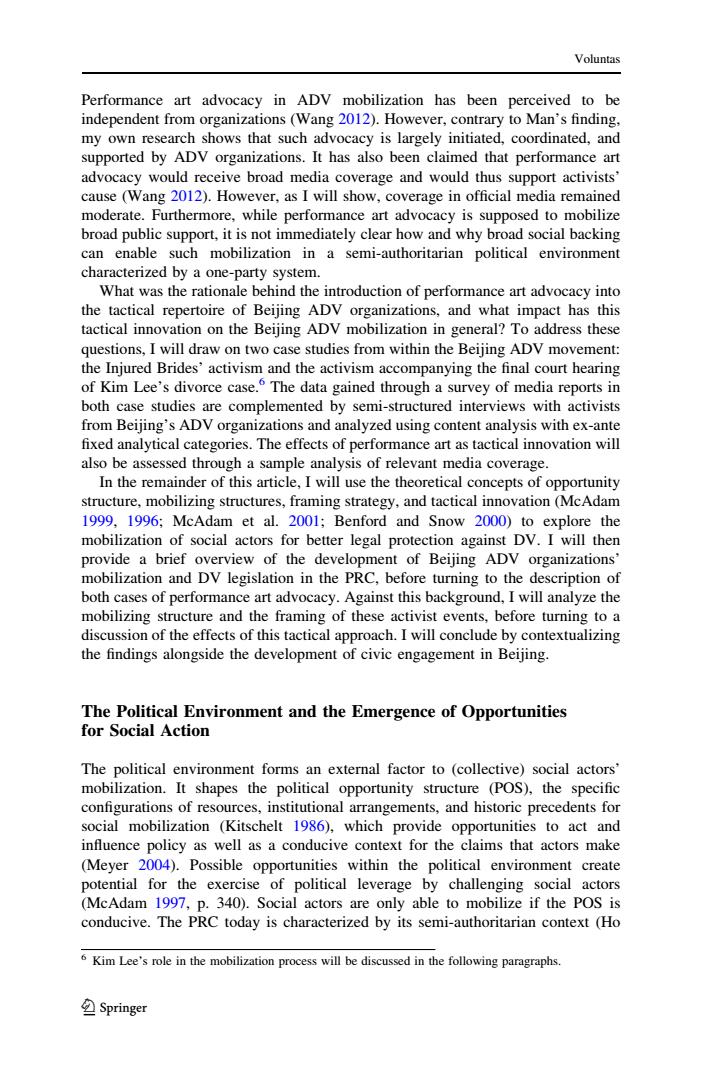正在加载图片...

Voluntas Performance art advocacy in ADV mobilization has been perceived to be independent from organizations (Wang 2012).However,contrary to Man's finding, my own research shows that such advocacy is largely initiated,coordinated,and supported by ADV organizations.It has also been claimed that performance art advocacy would receive broad media coverage and would thus support activists' cause (Wang 2012).However,as I will show,coverage in official media remained moderate.Furthermore,while performance art advocacy is supposed to mobilize broad public support,it is not immediately clear how and why broad social backing can enable such mobilization in a semi-authoritarian political environment characterized by a one-party system. What was the rationale behind the introduction of performance art advocacy into the tactical repertoire of Beijing ADV organizations,and what impact has this tactical innovation on the Beijing ADV mobilization in general?To address these questions,I will draw on two case studies from within the Beijing ADV movement: the Injured Brides'activism and the activism accompanying the final court hearing of Kim Lee's divorce case.The data gained through a survey of media reports in both case studies are complemented by semi-structured interviews with activists from Beijing's ADV organizations and analyzed using content analysis with ex-ante fixed analytical categories.The effects of performance art as tactical innovation will also be assessed through a sample analysis of relevant media coverage. In the remainder of this article,I will use the theoretical concepts of opportunity structure,mobilizing structures,framing strategy,and tactical innovation(McAdam 1999,1996;McAdam et al.2001;Benford and Snow 2000)to explore the mobilization of social actors for better legal protection against DV.I will then provide a brief overview of the development of Beijing ADV organizations' mobilization and DV legislation in the PRC,before turning to the description of both cases of performance art advocacy.Against this background,I will analyze the mobilizing structure and the framing of these activist events,before turning to a discussion of the effects of this tactical approach.I will conclude by contextualizing the findings alongside the development of civic engagement in Beijing. The Political Environment and the Emergence of Opportunities for Social Action The political environment forms an external factor to (collective)social actors' mobilization.It shapes the political opportunity structure (POS),the specific configurations of resources,institutional arrangements,and historic precedents for social mobilization (Kitschelt 1986),which provide opportunities to act and influence policy as well as a conducive context for the claims that actors make (Meyer 2004).Possible opportunities within the political environment create potential for the exercise of political leverage by challenging social actors (McAdam 1997,p.340).Social actors are only able to mobilize if the POS is conducive.The PRC today is characterized by its semi-authoritarian context (Ho 6 Kim Lee's role in the mobilization process will be discussed in the following paragraphs. 2SpringerPerformance art advocacy in ADV mobilization has been perceived to be independent from organizations (Wang 2012). However, contrary to Man’s finding, my own research shows that such advocacy is largely initiated, coordinated, and supported by ADV organizations. It has also been claimed that performance art advocacy would receive broad media coverage and would thus support activists’ cause (Wang 2012). However, as I will show, coverage in official media remained moderate. Furthermore, while performance art advocacy is supposed to mobilize broad public support, it is not immediately clear how and why broad social backing can enable such mobilization in a semi-authoritarian political environment characterized by a one-party system. What was the rationale behind the introduction of performance art advocacy into the tactical repertoire of Beijing ADV organizations, and what impact has this tactical innovation on the Beijing ADV mobilization in general? To address these questions, I will draw on two case studies from within the Beijing ADV movement: the Injured Brides’ activism and the activism accompanying the final court hearing of Kim Lee’s divorce case.6 The data gained through a survey of media reports in both case studies are complemented by semi-structured interviews with activists from Beijing’s ADV organizations and analyzed using content analysis with ex-ante fixed analytical categories. The effects of performance art as tactical innovation will also be assessed through a sample analysis of relevant media coverage. In the remainder of this article, I will use the theoretical concepts of opportunity structure, mobilizing structures, framing strategy, and tactical innovation (McAdam 1999, 1996; McAdam et al. 2001; Benford and Snow 2000) to explore the mobilization of social actors for better legal protection against DV. I will then provide a brief overview of the development of Beijing ADV organizations’ mobilization and DV legislation in the PRC, before turning to the description of both cases of performance art advocacy. Against this background, I will analyze the mobilizing structure and the framing of these activist events, before turning to a discussion of the effects of this tactical approach. I will conclude by contextualizing the findings alongside the development of civic engagement in Beijing. The Political Environment and the Emergence of Opportunities for Social Action The political environment forms an external factor to (collective) social actors’ mobilization. It shapes the political opportunity structure (POS), the specific configurations of resources, institutional arrangements, and historic precedents for social mobilization (Kitschelt 1986), which provide opportunities to act and influence policy as well as a conducive context for the claims that actors make (Meyer 2004). Possible opportunities within the political environment create potential for the exercise of political leverage by challenging social actors (McAdam 1997, p. 340). Social actors are only able to mobilize if the POS is conducive. The PRC today is characterized by its semi-authoritarian context (Ho 6 Kim Lee’s role in the mobilization process will be discussed in the following paragraphs. Voluntas 123